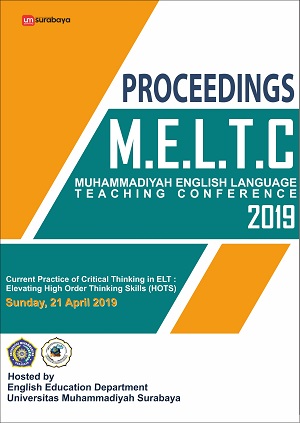Critical Thinking: From Psychological Perspectives To Pedagogical Prospectives In Efl Teaching Contexts
Abstrak
Critical thinking is necessary and therefore it is considered to be an essential mental attribute that students must master. It was once a means that was needed to be learned in order for a nation at risk not to degrade intellectually. Now, the teaching of critical thinking skills has shifted in orientation from saving a nation from intellectual degradation to equipping students with necessary skills required to survive in the next millenium. English as a school subject can contribute significantly to the empowerment of students in facing the 21st Century with critical thinking skills. Pedagogical approaches fitting the characteristics of critical thinking skills are there available. If so, then it is the critical role of EFL teachers to harness their students with critical thinking skills – the fifth skills in language learning – through their innovative and creative teaching delivery that really matters.
Keywords: English, critical, learning, skills, thinking
Referensi
Anderson, L.W. (Ed.), Krathwohl, D.R. (Ed.), Airasian, P.W., Cruikshank, K.A., Mayer, R.E., Pintrich, P.R., Raths, J., & Wittrock, M.C. (2001). A taxonomy for learning, teaching, and assessing: A revision of Bloom’s Taxonomy of Educational Objectives (Complete edition). New York: Longman.
Brinton, D.M., Snow, M.A., & Wesche, M. (2003). Content-Based Second Language Instruction.
Ann Arbor: The University of Michigan Press.
Cottrell, S. (2005). Critical Thinking Skills Developing: Effective Analysis and Argument.
Houndmills, Basingstoke, Hampshire: Palgrave Macmillan.
Caroselli, M. (2009). 50 Activities for Developing Critical Thinking Skills. Amherst, Massachusetts: HRD Press.
Dale, L. & Tanner, R. (2012). CLIL Activities: A Resource for Subject and Language Teachers.Cambridge: Cambridge University Press.
Devi, A. P., Musthafa, B., & Gustine, G. G. (2015). Using cooperative learning in teaching critical thinking in reading. English Review: Journal of English Education, 4(1), 1-14
El Soufi, N. & See, B.H. (2019). 'Does explicit teaching of critical thinking improve critical thinking skills of English language learners in higher education? a critical review of causal evidence.' Studies in Educational Evaluation, 60 . pp. 140-162.
Hudson, C.C. & Whisler, V.R. (2008).Contextual Teaching and Learning for Practitioners. Journal of Systemics, Cybernetics and Informatics, 6(4), pp. 54-58.
Keyes, R. (2004). The Post-Truth Era: Dishonesty and Deception in Contemporary Life. New York: St. Martin's Press
Lau, J.Y.F. (2011). An Introduction to Critical Thinking and Creativity: Think More, Think Better 1st Edition. Hoboken, NJ: John Wiley & Sons, Inc.
Livingston, J.A. 1997. Metacognition: An Overview. Accessed on 2 March 2019 from http://www.gse.bufallo.edu/fas/shuell/cep564/metacog.htm.
Martin, J. (2017). Critical Thinking and Metacognition. Acessed on 7 April 2019 from https://www.linkedin.com/pulse/critical-thinking-metacognition-jesse-martin/
McKay, D.R. (2019). Critical thinking: Why this is an essential skill. Acessed on 7 April 2019 from https://www.thebalancecareers.com/critical-thinking-525747.
Magno, C. (2010) The role of metacognitive skills in developingcritical thinking, Metacognition Learning (2010) 5:137–156DOI 10.1007/s11409-010-9054-4.
Murawski, L.M. (2014). Critical Thinking in the Classroom…and Beyond. Journal of Learning in Higher Education, 10(1), pp. 25-30.
Muslich, M. 2011. Pembelajaran Berbasis Kompetensi dan Kontekstual. Bumi Aksara. Jakarta. Nunan, D. (2001). Designing tasks for the communicative classroom. Cambridge, UK: Cambridge
University Press.
Stefanova, S., Bobkina, J., & Pérez, F.J.S-V. (2017). The Effectiveness of Teaching Critical Thinking Skills through Literature in EFL Context: A Case Study in Spain. International Journal of Applied Linguistics and English Literature. v.6n.6p.252. DOI: http://dx.doi.org/10.7575/aiac.ijalel.v.6n.6p.252
Patel, D. (2018). 16 Characteristics of Critical Thinkers. Entrepreneur Asia Pacific. Accessed on 12 April 2019 from https://www.entrepreneur.com/article/321660.
Permendikbud 22 Tahun 2016. Accessed on 12 April 2019 from https://portaldik.id/assets/upload/peraturan/
Permendikbud Nomor 103 tahun 2014. Accessed on 12 April 2019 from https://portaldik.id/assets/upload/peraturan/
Richards, J.C. (2006). Communicative Language Teaching Today. Cambridge: Cambridge University Press.
Ruggiero, V. R. (2012). The art of thinking: A guide to critical and creative thought (10th Ed.). New York, NY: Longman.
Sears, S. (2003). Introduction to Contextual Teaching and Learning. Bloomington, Indiana: the Phi Delta Kappa Educational Foundation.
Sukoco, M. (2017). Kerancuan Konsep Pendekatan Saintifik dalam Kurikulum 2013. Accessed on 11 April 2019 from https://medium.com/@maniksukoco/kerancuan-konsep-pendekatan- saintifik-dalam-kurikulum-2013-c9f32db40b35.
Sulistyo, G.H. (2015). EFL Learning Assessment at Schools: An Introduction to Its Concepts and Principles. Malang: CV. Bintang Sejahtera.
Tiruneh, D.T., Verburgh, A., & Elen, J. (2013). Effectiveness of Critical Thinking Instruction in Higher Education: A Systematic Review of Intervention Studies. Higher Education Studies, 4(1), pp. 1-17.
Trilling, B., & Fadel, C. (2009). 21st Century Skills: Learning for Life in Our Times. San Francisco, CA: Jossey-Bass.
Willingham, D. T. (2007). Critical Thinking: Why Is It So Hard to Teach? American Educator, 31, 8-19. Accessed on 1 April 2019 from http://www.aft.org/sites/default/files/periodicals/Crit_Thinking.pdf.
Doyle, A. (2019) Critical Thinking Definition, Skills, and Examples. Thebalancecareers. Accessed on 1 April 2019 from https://www.thebalancecareers.com/critical-thinking-definition- with-examples-2063745.
Wallen, D. (undated). 10 Signs You’re A Critical Thinker. Accessed on 1 April 2019 from https://www.lifehack.org/articles/productivity/10-signs-youre-critical-thinker.html.
Sieck. W. (undated). Critical Thinking Skills: What are They and How Do I Get Them? Accessed on 1 April 2019 from https://thinkeracademy.com/critical-thinking-skills/.
Scheffer, B. K. & Rubenfeld, M.G. (2001). Critical Thinking: What Is It and How Do We Teach It? in J.M. Grace, Rubl, H.K. (Ed). Current Issues in Nursing. New York: John Wiley.
Internet sources:
Groupmap. (undated). KWHLAQ. Accessed on 12 April 2019 from https://www.groupmap.com/map-templates/kwhlaq/.
What are 21st century skills? Accessed on 1 April 2019 from https://k12.thoughtfullearning.com/FAQ/what-are-21st-century-skills
Langwitches. (undated). Accessed on 3 April 2019 from http://langwitches.org/blog/2015/06/12/an- update-to-the-upgraded-kwl-for-the-21st-century/.






